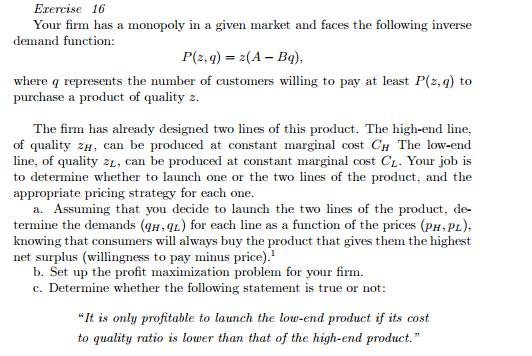Answered step by step
Verified Expert Solution
Question
1 Approved Answer
Exercise 16 Your firm has a monopoly in a given market and faces the following inverse demand function: P(z,q) = 2(A-Bq), where q represents

Exercise 16 Your firm has a monopoly in a given market and faces the following inverse demand function: P(z,q) = 2(A-Bq), where q represents the number of customers willing to pay at least P(z, q) to purchase a product of quality z. The firm has already designed two lines of this product. The high-end line, of quality z, can be produced at constant marginal cost CH The low-end line, of quality z, can be produced at constant marginal cost CL. Your job is to determine whether to launch one or the two lines of the product, and the appropriate pricing strategy for each one. a. Assuming that you decide to launch the two lines of the product, de- termine the demands (qH, qL) for each line as a function of the prices (PH,PL), knowing that consumers will always buy the product that gives them the highest net surplus (willingness to pay minus price). b. Set up the profit maximization problem for your firm. c. Determine whether the following statement is true or not: "It is only profitable to launch the low-end product if its cost to quality ratio is lower than that of the high-end product."
Step by Step Solution
There are 3 Steps involved in it
Step: 1
to see whether to launch one or two lines of the product ...
Get Instant Access to Expert-Tailored Solutions
See step-by-step solutions with expert insights and AI powered tools for academic success
Step: 2

Step: 3

Ace Your Homework with AI
Get the answers you need in no time with our AI-driven, step-by-step assistance
Get Started


